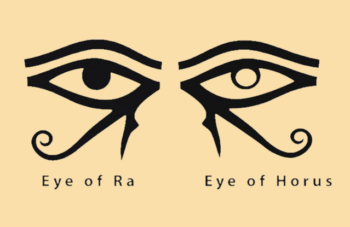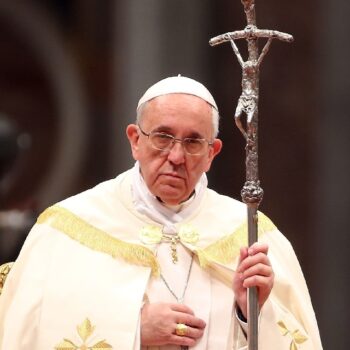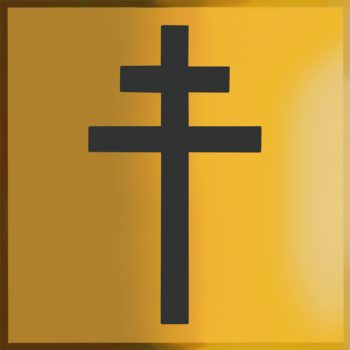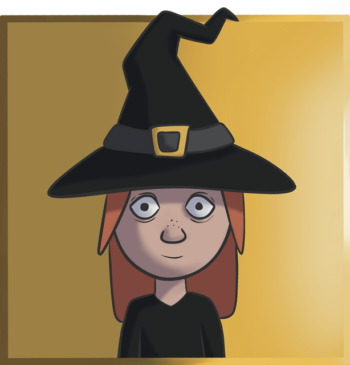Definition:
“Illuminati” refers to individuals who understand how language, religion, and the world system are scams.
Etymology:
The term “Illuminati” originates from Latin and means “the enlightened.” It is derived from the Latin word “illuminatus,” meaning enlightened or insight, and the Latin word “illuminare,” meaning to light up or shed light on.
Description:
The Illuminati were a secret society called the “Bavarian Illuminati,” founded on May 1, 1776, in Ingolstadt (in what is now Germany) by Adam Weishaupt, a professor of canon law. Weishaupt aimed to promote Enlightenment ideals, such as reason, secularism, and the rejection of religious and political tyranny. The group sought to influence society and reform governance without being bound by the influence of monarchies and churches. The original Bavarian Illuminati was a small, secretive organization that sought to influence social and political change, aligning itself with Enlightenment ideals. However, it was disbanded by the Bavarian government in 1785, after which it ceased to exist as an organized group.
Despite its brief existence, the Illuminati became a symbol of secret societies and was later co-opted by conspiracy theorists, particularly in the 20th and 21st centuries. Today, Illuminati is a term often used to refer to the large global society of the world’s most powerful individuals. The conspiracy theory about the Illuminati paints a very different picture than the official version we are all being told, which is that the world is governed by many different independent authorities, while the theory of the Illuminati claims that the world is secretly governed by a group orchestrating almost all major events on Earth with a common agenda to establish a new world order.
It is quite suspicious that the idea of the Illuminati being a group openly mocking the population for being too dumb to realize its existence is so strongly ridiculed by well-known and powerful individuals. For example, in an interview on “Jimmy Kimmel Live,” Jim Carrey parodies the All-Seeing Eye by making a triangle shape with his hands and sticking his tongue out in the center, calling it the “All-Mocking Tongue.” Click to watch the video clip.

Wearing rose-colored glasses is a metaphor for seeing only the positive and ignoring the negative. The Illuminati is quite the opposite, as it refers to a metaphorical lens through which one can see the negative where only the positive appears. For example:
“Through the Looking-Glass, and What Alice Found There” is a novel by Lewis Carroll, where Alice steps through a mirror in her house and finds herself in a world that is a reversed reflection of her own, where everything works in opposite ways.
Sunglasses are a symbol for filtering light, which symbolically means to filter away illusions.
The “Lens of Truth,” also known as the “Eye of Truth,” from the game series “The Legend of Zelda,” is an item that looks like a magnifying glass with an eye in it. When looking through this item, the game character Link can see invisible things and reveal falsehoods. For example, it can reveal invisible monsters or platforms for Link to jump on so he won’t fall. It can also expose false walls, that are holes in the walls that Link can actually walk through.

There is a video demonstrating some of the things the Lens of Truth can do in “The Legend of Zelda: Ocarina of TIme.” Click to watch the video.
Aluminum has some relation to the word “illumination” as aluminum is the most popular material used to make mirrors, and illumination can have a reflective meaning. Illumination means to light up or shed light on, but the angle from which you illuminate something gives a different effect. If you light up an object from behind, it creates a silhouette, meaning that what would otherwise be visible if illuminated from the front becomes invisible when illuminated from behind.
In bright religions like Judaism, Christianity, Islam, Hinduism, and Buddhism, light is posed as truth. These religions emphasize that you need light to see the truth. What the religions don’t tell you is that you must look in the darkness to see what does not exist. In the same way you close your eyes to dream: the only thing that still shines when everything is dark is imagination.
That something is “black and white” is a well-known saying that means something is so clear and obvious that it cannot be misinterpreted. This refers to the standardized way we write, with black text on a white background. But the saying is a lie, as light symbolizes imagination. There’s a reason why film credits are written in white on black after the movie is over; because the credits show you behind the scenes.
Elimination has some relation to the word “illumination” as the point of illuminating is to eliminate lies. When we illuminate fantasy words, we see a reverse meaning of the words, such as the famous quote from George Orwell’s book 1984 points out: “War is peace. Freedom is slavery. Ignorance is strength.”
Articles:
Authority
Definition: Authority refers to someone who determines others’ mandates and prohibitions. Etymology: The word authority originates from the Latin word “auctoritas,” which is composed of “auctor,” meaning creator, and “itas,”…
Big Brother
Definition: “Big Brother” is a term that refers to an authoritative or controlling figure or government that exercises oppressive surveillance and control over individuals. Etymology: The phrase “Big Brother” was…
Capitalism (The Global Monetary System)
Definition: Capitalism is a belief that ownership exists and how it can be improved. Capitalism is most commonly defined as an economic system characterized by private ownership of the means…
Conspiracy
Definition: A “conspiracy” involves two or more individuals with a shared agenda collaborating in opposition to others’ interests. (Even a surprise party for someone who wouldn’t want it can be…
Hierarchy
Definition: “Hierarchy” is a structure that categorizes units or individuals based on relative levels of authority, power, or importance. Etymology: The word “hierarchy” originates from the Greek word “hierarkhia,” composed…
Language
Definition: A language is a structured collection of patterns associated with ideas. Language is the tool of communication. Etymology: The word “language” comes from the Old French word “langage,” which…
Web of Language
Description: Religion works like a network in the brain. At the center of the web is the concept of God’s existence. In every cross of the web around the word…
Symbolism:
The Illuminati symbol is found on the reverse side of The Great Seal of the United States of America, and the back of the US one-dollar bill. It is meant to represent the values and aspirations of the United States when it was founded, but the symbolism can clearly be applied to the entire world system as it is run by capitalism.
The pyramid symbolizes the hierarchy among people. The top of the pyramid is missing but is replaced with the symbol of the Eye of Providence, also known as the Eye of God, to symbolize that God controls people from above. In other words, this symbolizes that the fantasy/lies of God’s existence control people. The idea is that you can work your way up the pyramid, but in reality, the top is only a lie. The Illuminati symbol represents how the entire world’s monetary system (the hierarchy) is a pyramid scheme where the majority at the bottom lift the few to reach a top that doesn’t exist. The back side of the US one-dollar bill includes the phrase “In God We Trust.”
The Illuminati pyramid is mainly a language symbol. A triangle pointing upwards is a symbol for the common language we are being taught, known as: “common language,” “general language,” “Christian language,” “bright language,” and “esoteric language.” (it’s important to understand that esoteric has the opposite meaning of what most people believe it has).
A triangle pointing downwards is a language symbol and symbolizes the language opposite to the Christian language. In other words, the “Satanic language,” the “dark language,” the “illuminated language,” the “exoteric language” (it’s important to understand that exoteric has the opposite meaning of what most people believe it has). In this opposite language, every fictional word has been given an opposite meaning. For example: “truth” means “lie” and vice versa, “left” means “right” and vice versa, “freedom” means “imprisonment” and vice versa, “love” means “hate” and vice versa, and “good” means “evil” and vice versa.
The symbolism of the opposite dimension of language can be found in any SLM symbols, such as the Star of David, or the Tree of Life.
There are some key features to look for when detecting an Illuminati symbol.
The original Illuminati symbol consists of an unfinished pyramid. The top of the pyramid is replaced by the All-Seeing Eye, also known as the Eye of Deception, symbolizing a lie. Therefore, any triangle shape with a detached top can be considered an Illuminati symbol.
Originally, all three pyramids at Giza—the Great Pyramid of Giza (Khufu), the Pyramid of Khafre, and the Pyramid of Menkaure—were capped with a pyramidion. A pyramidion is the capstone or the topmost piece of an ancient Egyptian pyramid. It was typically shaped like a small pyramid itself and would sit at the very apex of the larger pyramid structure, completing its form. Pyramidions were usually made from fine materials like polished limestone, granite, or basalt, and in some cases, they were covered in gold or electrum (a gold-silver alloy) to reflect the sunlight and shine brightly. However, none of the original pyramidions from the three Giza pyramids have survived to the present day. The Pyramid of Khafre no longer has its pyramidion, but it retains some of the original smooth casing stones near the top, which gives the impression that its peak is more “intact.” The pyramidion had significant religious and symbolic meaning in ancient Egyptian culture. It represented the benben, the mythical mound of creation in Egyptian mythology, where the sun god Ra was said to have emerged. As such, the pyramidion symbolized a connection between the earthly and the divine, and its position at the peak of the pyramid reflected the idea of ascending to the heavens. Over time, most of the outer casing stones of the entire pyramid were removed. It is claimed that it’s either due to natural erosion or because they were repurposed for building projects in Cairo and other nearby areas. However, it’s likely that there has been a long-term coordinated effort by authority to deliberately strip away stones in a symbolic pattern over centuries. From ancient dynasties to foreign rulers such as the Romans, Arabs, and later the Ottomans.

The poster for the movie “The Pyramid” (2014), features a pyramid partially submerged in sand. There’s a distinct line of sand that separates it from the underground, symbolizing the top of the Illuminati pyramid. Underground the sand continues the pyramid‘s shape, and the mummy’s missing eye creates a hollow right eye socket, positioned within the pyramid shape, subtly forming the Eye of Providence symbol. It’s worth noting that the letter “A” in the title “The Pyramid” on the movie poster is replaced by a simple filled triangle, mimicking the shape of a pyramid.

The symbol for the capital letter “A” consists of two slanted lines placed diagonally against each other, resembling an arrow pointing upwards. In the middle of these two slanted lines is a horizontal line intersecting them. The symbol can also be described as a triangle, with the two diagonal lines extending slightly beyond the base corners. This resembles the Illuminati symbol.
The design of the Marlboro cigarette pack features a white chevron. The top of the chevron has a triangular shape, similar to the top of an upward-pointing triangle. When the pack is opened, the top of the white chevron separates from the rest, resembling how the All-Seeing Eye is separated from the pyramid in the Illuminati symbol.

The cover for the French electronic music duo Daft Punk’s music album: “Alive” (2007) features a pyramid with its top section detached and hovering above the base, creating a distinct separation between the two parts.

The stage for Daft Punk’s “Alive” 2007 tour featured a pyramid with its top section detached and hovering above the base, creating a distinct separation between the two parts. Both sections of the pyramid were covered with LED screens displaying vivid imagery, including a large single human eye.
The movie “Lara Croft: Tomb Raider” (2001) revolves around the adventurous and skilled archaeologist Lara Croft as she embarks on a dangerous quest to stop a secret society known as the Illuminati from acquiring an ancient and powerful artifact called the “Triangle of Light,” which features the All-Seeing Eye. The Triangle of Light is a relic that can control time. It was split into two pieces and hidden in different parts of the world long ago to prevent its immense power from being misused. The Illuminati seek to reunite the pieces during a rare celestial event called the planetary alignment, which occurs once every 5,000 years, to gain control over time itself.
In the film’s climax, the Illuminati manage to reunite the two halves of the Triangle of Light, which pulls Lara and the antagonist Manfred Powell into a dimension where a pyramid appears, with the Triangle of Light rotating in the air above it. They race each other up the pyramid, and Lara wins by reaching the Triangle of Light first, causing Manfred to fall off the pyramid. Click to watch the video clip.
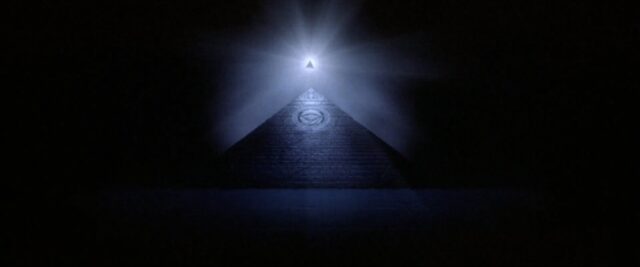
Loomis AB, a Swedish security company that operates internationally, specializes in cash handling, secure logistics, and solutions for the management of physical currency and valuables. Loomis provides services such as armored transportation, cash processing, ATM services, and vault solutions for banks, retailers, and other businesses.
The company’s name, “Loomis,” comes from Lee Loomis, who founded an armored transport service in the United States in 1905. The original company was known as “Loomis Armored Car Service,” which provided secure transportation of cash and valuables. Over time, Loomis merged with other companies and evolved into the modern Loomis AB, a global leader in cash handling and security services.
The name “Loomis” is believed to have roots in the Old English or Middle English term “lomes,” which meant a “pool” or “slow-moving river.” While the name itself may seem meaningless, it bears some resemblance to words like “luminous,” which comes from the Latin root “lumen,” meaning “light.” The addition of a red pyramid above the company name, along with the fact that their business involves money, raises suspicions of intentional Illuminati symbolism.

The movie poster for “Transformers: Revenge of the Fallen” (2009) features a glowing sun setting behind the top of a pyramid.
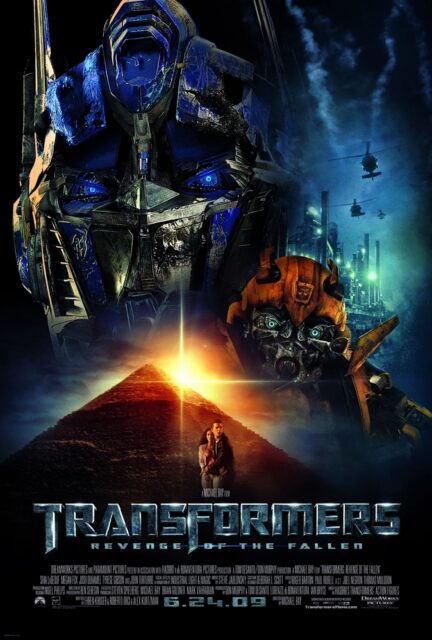
The movie poster for “Jumper” (2008) features the main character, David Rice, in mid-jump, reaching forward while teleporting. Behind him, a swirl of blue and orange energy represents his ability to “jump” or teleport from one place to another. His right arm, extended forward, covers his right eye, leaving only his left eye visible through the arc of his hand, subtly forming the symbol of Islam. At the bottom of the poster, parts of several ancient Egyptian structures are shown. The sun glows behind the top of one of the pyramids, together forming the Illuminati symbol. The face of the Great Sphinx of Giza is only partially in frame, with just its left eye visible. The one–eye symbolism, along with the pyramid, reinforces Illuminati symbolism, fitting with the fantasy theme of the movie, as teleportation is impossible.
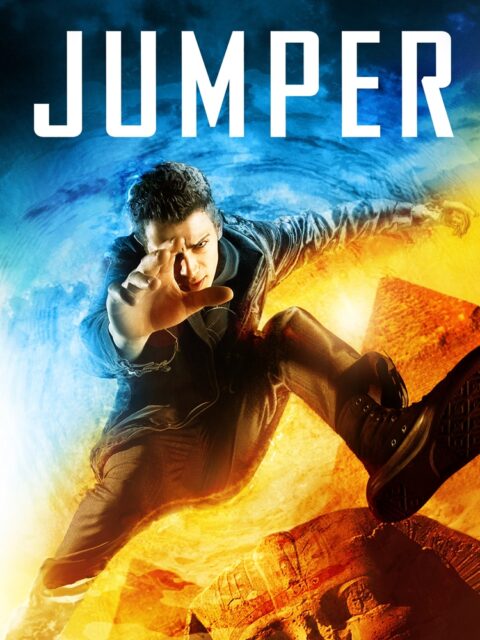
In the music video for “Rihanna – Don’t Stop the Music,” Rihanna opens the curtains and walks through them. As she opens them, creating a triangular opening, a purple-colored stage light peeks through the top of the opening. Together, the stage light and the triangular-shaped opening form the Illuminati symbol.

There’s a scene in the animated movie “We’re Back! A Dinosaur’s Story” (1993) where two children, Cecilia and Louie, enter “Professor Screweyes’ Eccentric Circus.” The one–eyed antagonist Professor Screweyes catches them laughing as they peek through the entrance, watching the clown’s silly behavior. He uses reverse psychology to lure the children into the circus tent by telling them it’s closed while closing the curtains in front of them, but leaving a small opening. As Professor Screweyes closes the curtain, his eye is visible through an upside-down, triangular-shaped gap, symbolizing the Eye of the Devil. Cecilia’s right eye then peeks through the tiny triangle-shaped opening before she steps in, leaving only Louie, with one eye visible, peeking in. Click to watch the video clip.
A mountain is often used as an Illuminati symbol and is typically drawn with a pointy, snowy peak.
The animated movie “Smallfoot” (2018) follows a young Yeti named Migo, who lives in an isolated village high up in the mountains, where they believe the mountain comprises the entire world. These mountains are shielded by a thick layer of clouds that hide the village from the human world below. The explanation they’ve been given about their existence is that their world fell out of the butt of the great sky yak, that the mountain floats on clouds held up by giant mammoths, and that they must feed ice to the mammoths so they don’t overheat. In reality, when they feed the machine with ice, the steam/clouds are produced to conceal them from seeing the world below. When Migo has an unexpected encounter with a human pilot who crashes into the mountains, he begins to doubt everything he’s been told and sets out to discover the truth about “Smallfoot.” This leads him to expose the entire conspiracy that upholds the meaningless labor machine. Click to watch the video clip.

The Parliamentary Triangle of Canberra, Australia, also known as The National Triangle, is an architectural layout that was carefully designed by Walter Burley Griffin, the city’s chief planner, in the early 20th century, to resemble the Illuminati symbol. The city of Canberra is the political and cultural capital of Australia, and the triangle was designed to highlight the balance between the legislative, executive, and judicial branches of government. The placement of buildings within the Parliamentary Triangle reflects the hierarchy of power:
- Parliament House (at the apex): As the highest point of the triangle, it represents the central authority and power of the legislative branch. Its elevated position on Capital Hill literally and symbolically places it above everything else, signifying its supreme role in governing the nation.
- Old Parliament House: Positioned along the main axis leading up to New Parliament House, it sits lower, showing the progression of governance over time. Though historically important, its placement reflects its current role as a museum, subordinate to the active Parliament.
- The High Court of Australia (on the eastern side): While it isn’t directly on the same axis as Parliament House, its position on one corner of the triangle represents the judiciary’s critical but distinct role in maintaining the rule of law and balancing parliamentary power.
- Cultural Institutions (National Gallery, National Library, National Archives): These buildings, located on the triangle‘s base, represent the cultural and intellectual foundations of the nation. While they don’t hold direct governmental power, their positioning underscores their importance in supporting and documenting Australia’s political and societal framework.

There’s a patte d’oie formation of Hampton Court and Hampton Court Park in London, England. The palace is located at the top center, near the Thames River, and is surrounded by its famous formal gardens, with Hampton Court Park (also called Home Park) partly within the large triangular layout. The geometric precision of the design was intended to showcase the power and control of the monarchy or estate owners, reflecting the broader ideals of the Baroque era. The triangle leads toward Hampton Court Palace, drawing the eye toward the royal residence and enhancing its grandeur.
Hampton Court Palace was originally built for Cardinal Wolsey in the early 16th century and later became a royal palace under King Henry VIII. The palace and its surrounding gardens are a major historical site and tourist attraction, known for their Tudor and Baroque architecture, as well as the famous Hampton Court Maze.
The palace itself was designed to be a symbol of royal wealth and power. Its size, lavish design, and sheer grandeur were intended to demonstrate the monarchy’s dominance over both its subjects and other European powers. Such a project required enormous financial investment.

There’s a triangular-shaped park called Centerpiece Park, featuring an eye-like design at its center. It’s located between the Century Plaza Towers (also known as the Twin Towers of Century City) and 2000 Avenue of the Stars, in Century City, Los Angeles, California, USA.
Century City, where these buildings are located, is a significant commercial district in Los Angeles. Originally developed as part of 20th Century Fox’s studio lot, the area has become a major center for business, finance, entertainment, and law, making it one of the most important business districts in the region.
The Century Plaza Towers and 2000 Avenue of the Stars are primarily corporate office buildings that serve as bases for legal, financial, and entertainment industry companies in Los Angeles. They play a critical role in the city’s corporate and entertainment sectors, hosting the headquarters of major firms and providing space for professional activities.
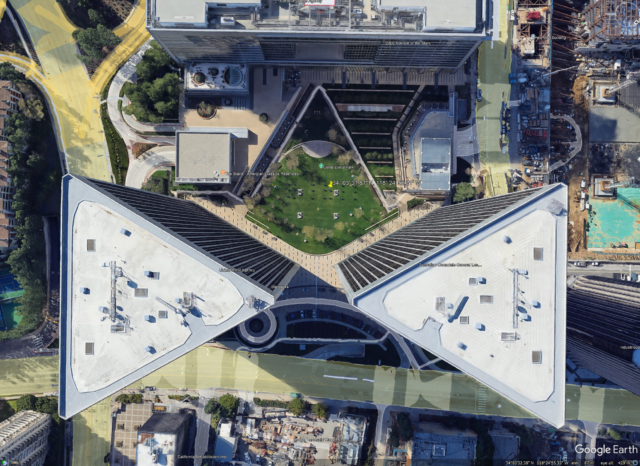
There’s a patte d’oie formation in the city of Versailles, located in the Île-de-France region, just west of Paris, France. At the top of the goose foot is the Palace of Versailles (Palais de Versailles), which is one of the most famous and opulent royal residences in the world. The palace became the official residence of the French monarchy and the seat of political power in France from 1682 until the French Revolution in 1789. The palace became a symbol of absolute monarchy, with Louis XIV, the “Sun King,” using its grandeur to reinforce his power. During the French Revolution, the royal family was forced to leave Versailles, and the palace ceased to be the seat of power. Today, it is a UNESCO World Heritage Site and a museum. The Place d’Armes, which is located directly in front of the Palace of Versailles, is a large, open square that serves as the main entrance area to the palace grounds. The Place d’Armes is where several roads converge, creating a triangular shape.

There’s a patte d’oie formation in Washington, D.C., USA, in the area surrounding the White House. Several streets and avenues, such as Pennsylvania Avenue, radiate outward from the vicinity of the White House. The White House is situated at the top of a triangular formation created by Vermont Avenue NW and Connecticut Avenue NW in Washington, D.C. These two streets radiate outward from the area near Lafayette Square, forming two of the sides of the triangle, with the White House at the apex.
The White House is the official residence and workplace of the sitting President of the United States. In addition to being a home, the White House is also the main venue for official presidential functions, meetings with foreign leaders, and other state events.

In Washington, D.C., there is a massive triangle of streets both in front of and behind the U.S. Capitol Building, with the Capitol at the apex of each triangle.
Many of the buildings within these triangular areas are significant, particularly in and around Capitol Hill, which is home to important government institutions. For example:
- Capitol Building: The U.S. Capitol is the centerpiece of this area and serves as the seat of the U.S. Congress, making it one of the most important buildings in the country.
- Supreme Court Building: Located near the Capitol, it houses the U.S. Supreme Court, the highest judicial authority in the country.
- Library of Congress: Also nearby, this is the largest library in the world and a vital resource for legislative research and historical archives.
- Senate and House Office Buildings: Buildings such as the Hart and Dirksen Senate Office Buildings and the Cannon and Longworth House Office Buildings house offices for members of Congress and their staff.
The Illuminati symbol is often created by combining a star (often the sun) or moon with a triangle or pyramid shape.
Jesus Christ is a metaphor for the sun. When the sun sets over water, the reflection on the water’s surface creates a triangular shape that points toward the sun. Together, the sun and the triangular reflection form the Illuminati symbol. This parallels the story of Jesus walking on water from the New Testament of the Bible.

An advertisement for the Nokia 7610, a mobile phone model released in the mid-2000s, features a mountain with a full moon behind its peak, together forming a symbol reminiscent of the Illuminati. The full moon, partially obscured, creates arc-symbolism similar to that of a crescent moon. The advertisement highlights a striking visual concept, with the phone positioned in the center against a background symbolizing contrasting elements—one side representing ice or cold (blue and snowy) and the other side symbolizing heat or fire (red and cracked earth), emphasizing left and right symbolism, which is also present in arc-symbolism. The symbolism in the ad fits the intention of selling a camera phone very well, reinforced by the tagline: “Capture your Imagination,” which also emphasizes that the Illuminati symbol is a fantasy symbol.

The movie poster for “Alpha and Omega” (2010) features a triangular-shaped composition of a rocky mountain landscape, with a full moon rising behind the mountain peak, together forming the Illuminati symbol. From our perspective, the female wolf is on the left and the male wolf is on the right, with their heads tilted to reveal only one eye each— the left eye for the female and the right eye for the male. This one–eye symbolism within the triangular composition evokes the Eye of Providence. Along with the title “Alpha and Omega” referring to God, this reinforces the symbolic theme of the cover art.

In the animated television series “Pokémon Indigo League, Episode 06: Clefairy and the Moon Stone,” a scientist named Seymour drops to one knee and stretches his arms out in a T-pose, mimicking Jesus Christ on the cross. He is drawn from behind at the tip of a pointed hill with the sun in front of him, while screaming, “I’m alive,” which can be decoded to mean “I am a lie I have,” “eye am a lie eye have,” and “eye am a lie I have.” The sun behind the pointed hill forms the Illuminati symbol. Click to watch the video clip.

In the stop-motion movie “Chicken Run: Dawn of the Nugget” (2023), chickens trapped in a high-tech poultry processing plant—disguised as “Fun-Land Farms”—are controlled through electronic collars that hypnotize them into becoming dumb, compliant, and blissfully unaware of their fate. The illusion of happiness is reinforced by their artificial surroundings, including a hill with a glowing sun at its peak—symbolizing the Illuminati pyramid.
The tiered structure of the hill gives it a striking resemblance to the Tower of Babel.
One striking scene demonstrates this sinister technology: a chicken is remotely controlled as the hill splits open, revealing an escalator leading upward. As she ascends, the other chickens watch in awe and envy, mirroring the way society admires those who climb the corporate ladder within the Illuminati structure. One chicken remarks, “She’s won the prize,” and the entire crowd joyfully chants, “What a lucky ducky!”
Upon reaching the summit, the chicken steps through the glowing sun—vanishing from the fun-land—before the chilling sound of slaughter is heard. Moments later, a bucket of chicken nuggets is presented to the human operators of the factory, revealing the dark truth behind the illusion.
This scene serves as a powerful metaphor for the deception society lives under—believing that climbing the Illuminati pyramid leads to success and fulfillment, when in reality, the perceived rewards are an illusion, and the negative consequences far outweigh the perks.
Click to watch the video clip.
The cover for the family Christmas movie “Nativity 2: Danger in the Manger!” (2012) features a group of people arranged in the shape of a Christmas tree, symbolizing the Illuminati pyramid. The children are dressed in nativity-themed costumes, with a child dressed as a five-pointed star at the top.

In the movie poster for “The Lord of the Rings: The Two Towers” (2002), the moon is placed behind the Tower of Barad-dûr, resembling the Illuminati symbol.

In the fantasy franchise “The Lord of the Rings,” there is an eye at the top of a tower referred to as “The Eye of Sauron” or “The Eye of Mordor.” The Eye of Sauron is a powerful and malevolent force belonging to the character Sauron, a dark lord who rules over the region of Mordor. The eye is described as an all-seeing eye that symbolizes Sauron’s surveillance and control over the world, always searching for the One Ring, the source of his power. The eye on top of the tower also forms the Illuminati symbol.
In “The Lord of the Rings,” there are two towers, but there is also a volcano called Mount Doom, which carries Illuminati symbolism. On top of Mount Doom, we see a fiery glow from the Cracks of Doom, the volcanic fissure inside the mountain where the One Ring was originally forged by Sauron. This fiery light symbolizes the immense heat and molten lava within Mount Doom, the only place where the One Ring can be destroyed. In The Lord of the Rings, the Ring must be thrown into this fiery chasm to be undone, as no other force in Middle-earth is powerful enough to destroy it.
Kevin McCallister stands on the roof of the South Tower of the World Trade Center, taking pictures and enjoying the view. A tower carry similar symbolism to that of a pyramid, as seen with the symbolism of an obelisk and how the Tower of Babel shares symbolic meaning with the Illuminati pyramid. Kevin, standing on the roof and looking through the viewfinder of his Polaroid camera, closes his left eye, leaving only his right eye open. One eye on top of a tower forms the Illuminati symbol. Click to watch the video clip.
On a movie poster for “Die Hard” (1988), the Nakatomi Plaza, a fictional name for the real-life Fox Plaza building in Los Angeles, covers the right half of John McClane’s face, leaving only his left eye visible. The top of the building is exploding, a visual reminiscent of the World Trade Center. Together, the building and McClane’s visible eye form a striking resemblance to the Illuminati symbol.
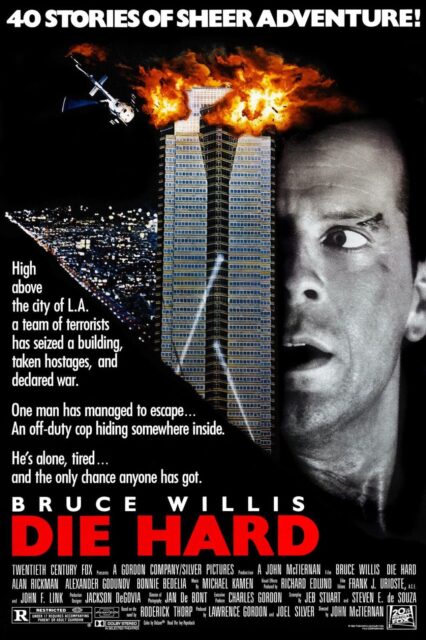
The single cover for “You’re Toxic” (2022) by Deborah De Luca features a red-tinted portrait of her within an incomplete red circle, evoking arc-symbolism. A semi-transparent black rectangle covers her right eye, and where it overlaps with the semi-transparent black triangle, the area becomes even darker. Her right eye is hidden within the top of the triangle, leaving only her left eye visible outside of it. At the bottom center, a white silhouette logo of a woman inside an arc appears. Although only the left eye of the woman is intended to be visible, it is hidden as part of the silhouette. The arc together with the eye forms the symbol of Islam.

Both the film cover and the movie poster for the Hong Kong-Singaporean horror film “The Eye” (2002) feature a young boy standing on a walkway that narrows as it leads toward a large human eye, which together resemble the Illuminati symbol.
On the movie poster for “The Chronicles of Narnia: The Lion, the Witch and the Wardrobe” (2005), the White Witch, along with the rocky ledge she’s standing on, forms a triangular shape. Her head is tilted to the side, revealing only her right eye, which together creates the Illuminati symbol. In the distant background, the two-towered Castle of Cair Paravel is visible in front of a full moon, further forming another Illuminati symbol.

The movie poster for the science fiction thriller “I Am Mother” (2019) features a large robot with a glowing red eye that emits light downward in a triangular shape, forming the Illuminati symbol. A teenage girl is depicted in the robot’s palm, running as if trying to escape its grasp. The Illuminati imagery, combined with the title “I Am Mother,” evokes themes of authority, surveillance, and control.
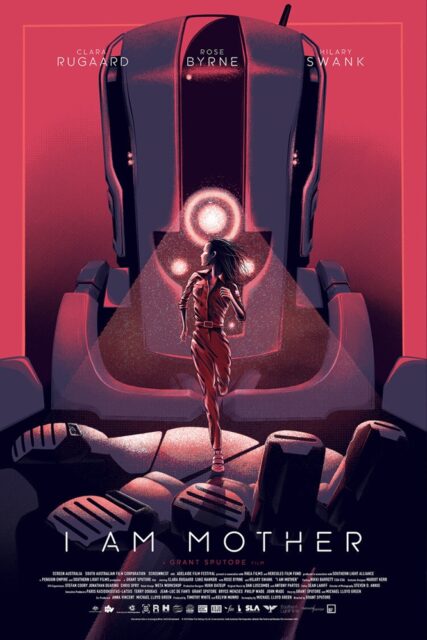
A poster for the series “The Sandman” (2022) features the main character, Dream, in the center, dressed in a long, dark black coat that forms a distinct triangle shape. A glowing, star-shaped magical circle with symbols is placed above this triangle, together forming a symbol resembling the Illuminati pyramid. The black raven perched on Dream’s shoulder has its head turned to the side, making only its left eye visible within the magical circle, which emphasizes the Illuminati symbolism.

An image of Melanie Martinez, taken before her streamed virtual concert titled “Can’t Wait Till I’m Out of K-12” in 2020, featured her in a hoop skirt structure with a cage-like appearance, reminiscent of historical crinolines or panniers worn in the 18th and 19th centuries to hold out skirts. However, this frame was not concealed by fabric, giving it a unique, avant-garde look. She was holding a ferris-wheel-like umbrella in front of her face, covering her right eye. The conical shape of the skirt, combined with the umbrella, forms the Illuminati symbol. The eye within the umbrella emphasizes this symbolism.

The poster for the movie “Total Recall” (1990) features the right half of a man’s face in grayscale, with only his intense right eye visible. Below, a volcanic, pyramid-like structure erupts against a fiery red-orange background. Together, the pyramid and the single visible eye form a symbol resembling the Illuminati. A planet and an eclipse are visible in the sky above the pyramid-like structure.

There’s an art piece by H.R. Giger that appears in the Alien movie franchise, containing the Illuminati symbol along with alien imagery. Covering the entire art piece is an alien creature resembling the Egyptian sky goddess Nut. The imagery within the triangle depicts the alien life cycle of the fictional creatures in the franchise called Xenomorphs.
The life cycle begins with an egg, also known as an ovomorph. These eggs are typically laid by the Xenomorph Queen, a larger and more intelligent variant of the species. The egg remains dormant until a potential host approaches, at which point it activates and opens up. When the egg opens, it releases a creature called the Facehugger. The Facehugger is a small, spider-like organism with long, bony fingers and a tail. Its sole purpose is to implant an embryo into a host. Once mature enough, the embryo violently bursts out of the host’s chest, killing the host in the process.
The artwork portrays these stages, with the first stage at the top and the third stage at the bottom.
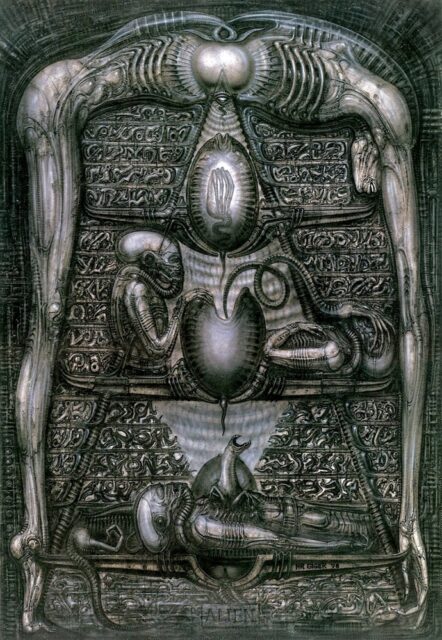
The cover art for the first-person shooter video game “The Conduit,” which revolves around Michael Ford, a secret service agent who is recruited by a shadowy organization called “The Trust” to combat an alien invasion in Washington, D.C., features the Illuminati symbol. The All-Seeing Eye is a central piece of technology Ford uses in the game. It allows him to uncover hidden objects, detect invisible enemies, and activate alien devices. The device’s name directly references the “Eye of Providence“, which is often associated with the Illuminati. This connection to hidden knowledge and perception aligns with the cover’s symbolism of the eye, representing the theme of uncovering secrets.

The opening credits of the TV sitcom “The Big Bang Theory” are fast-paced and visually dynamic, capturing the essence of science and the history of the universe. The theme song, “The History of Everything” by the band Barenaked Ladies, plays during the credits, summarizing the evolution of the universe from the Big Bang to modern civilization in just a few seconds. We are shown images from the beginning of the universe, through key moments in history, to the present day. When the lyrics say, “We built the pyramids,” the Illuminati pyramid is briefly shown. Click to watch the video clip.
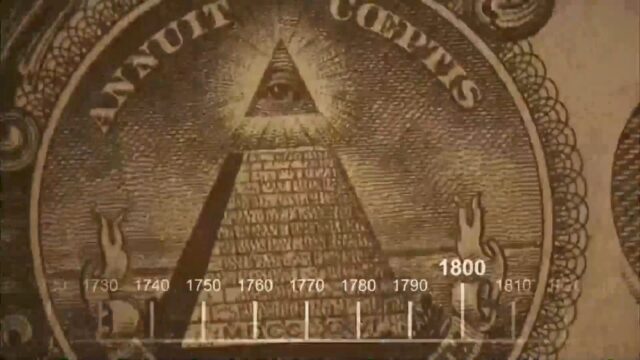
The opening credits of the American political talk show “Real Time with Bill Maher” feature a row of four washing machines, with parts of U.S. dollar bill imagery rotating in each drum. This carries a double meaning, symbolizing both brainwashing by Illuminati lies and the whitewashing of money. A piece of three of the images is missing, partially or completely hiding one eye in each image. The rotating Illuminati pyramid also symbolize the duality of language.

In the opening scene of the movie National Treasure (2004), the grandfather, John Adams Gates, tells his grandson, a young Ben Gates, a story of how a secret came to be. “What was the secret?” Ben asks. The grandfather replies, “A treasure. A treasure beyond all imagining.” Everything but his right eye fades out and is replaced with pyramids. His eye remains above a pyramid that is missing its top. This emphasizes how both the eye and the Illuminati pyramid symbolize a secret. Click to watch the video clip.

A scene in the movie “Sherlock Holmes” (2009) depicts a top-secret meeting filmed in Freemasons’ Hall in London. On the wall behind a golden throne, outside the Grand Temple, we see a sunburst pattern radiating from a triangular base, which resembles the Illuminati symbol. The room is filled with childish elderly men dressed in elaborate costumes, referred to as formal, ceremonial attire, which is typical of Freemason rituals.

The poster for the shortfilm “Haber” (2008), which is about a German-Jewish chemist’s development of chemical weapons during World War I, features the Star of David as the letter “A” in the title “Haber,” emphasizing the actual symbolic meaning for the letter “A.”
The Star of David is placed at the top of the letter “A,” resembling the way a star can be placed atop a triangular shape to symbolize the Illuminati, as is commonly seen, for instance, with the star on a Christmas tree.

Articles:
A
Definition: The letter “A” is the first letter of many alphabets, including but not limited to the modern English alphabet. Etymology: The symbol for the letter “A” originates from the…
A Wolf Howling in Front of a Full Moon
Description: The idea that wolves howl more during a full moon is a popular myth, but there is no evidence to support this. Wolves howl for various reasons, such as…
Anthill
Definition: An “anthill” is a mound-like structure built by ants, consisting of soil, sand, or other materials, which serves as the entrance and ventilation system to their underground colony. It…
Caduceus
Definition: The “caduceus” is a symbol traditionally associated with Hermes (Mercury in Roman mythology), the Greek god of messengers, commerce, and trade. It features a short staff entwined by two…
Christmas Tree
Definition: A “Christmas tree” is an evergreen tree, often a fir, spruce, or pine, decorated with lights, ornaments, tinsel, and other Christmas decorations. Etymology: The term “Christmas tree” combines “Christmas,”…
Cone
Definition: A cone is a geometric figure with a circular base that tapers evenly to a single point, called the apex. Etymology: The word “cone” originates from the Latin word…
Cosmic Mountain
Definition: A “cosmic mountain” is a symbolic and mythological representation of a sacred or significant mountain that connects the heavens and the earth. It is seen as a central axis…
Dunce Cap
Definition: A “dunce cap” is a tall conical hat historically used as a form of punishment in schools. Etymology: The term “dunce” originates from the name of John Duns Scotus,…
Eye
Definition: The “eye” is a complex sensory organ responsible for vision. It detects light and converts it into electrochemical signals, which are then processed by the brain to produce images….
Eye of Deception
Definition: The “Eye of Deception” is a symbolic representation that what is being observed or conveyed is false or misleading. It serves as a warning or indication that what is…
Eye of Fantasy
Definition: “Eye of Fantasy” refers to the symbol of a single eye used to represent a situation that is impossible, unrealistic, or inaccurate. It is often used to indicate that…
Eye of Jesus
Definition: The term “Eye of Jesus,” also known as the “Eye on the Cross,” typically refers to a metaphorical or symbolic concept within Christian theology and spirituality. It is not…
Eye of the Devil
Definition: The “Eye of the Devil” typically refers to a malevolent, watchful gaze that symbolizes evil, misfortune, or a sinister presence. It can be interpreted literally, as an actual eye…
Eye of Truth
Definition: The “Eye of Truth” is a symbolic concept carrying dual meanings. The Eye of Truth is used by spiritual people as a metaphor for seeing that which does not…
Eyes of Horus
Definition: The “Eyes of Horus” is an ancient symbol originating from ancient Egyptian mythology where a set of two eyes were referred to as the Eyes of Horus, Udjat, or…
Greek Cross
Definition: The “Greek Cross” is a type of cross with four arms of equal length, intersecting at right angles. Etymology: The term “Greek Cross” originates from its prominent use in…
Jerusalem Cross
Definition: The “Jerusalem Cross,” also known as the “Crusader’s Cross,” is a Christian symbol consisting of a large cross potent (a cross with crossbars at the ends) surrounded by four…
Mountain
Definition: A “mountain” is a large natural elevation of the earth’s surface that rises steeply from the surrounding level. Mountains are formed through geological processes such as plate tectonics, volcanic…
One (1)
Definition: The number “1” is the first and smallest natural number. It represents a unit, a single entity, or a quantity of one. In arithmetic, 1 serves as the multiplicative…
Orthodox Cross
Definition: The “Orthodox Cross,” often referred to as the Russian Orthodox Cross, is a distinct Christian cross associated particularly with the Eastern Orthodox Church. Etymology: The term “Orthodox” comes from…
Papal Ferula
Definition: A “papal ferula” is a ceremonial staff carried by the Pope. Etymology: The term “ferula” comes from the Latin word “ferula,” meaning “rod” or “staff.” It has historically been…
Party Hat
Definition: A “party hat” is a festive accessory typically worn at celebrations such as birthdays, New Year Transition, and other joyous events. Etymology: The term “party hat” combines “party,” which…
Patriarchal Cross
Definition: The “Patriarchal Cross” is a variant of the Christian Cross featuring two horizontal crossbars, with the upper one shorter than the lower one. Etymology: The term “patriarchal” comes from…
Pattée Cross
Definition: The “Pattée Cross” (also spelled “Pattee”, “Patee”, or “Paty”) is a distinct form of Christian cross with arms that are narrow at the center and flare out in a…
Pyramid
Definition: A pyramid is a geometric shape with a polygonal base and triangular sides meeting at a single apex. Etymology: The term “pyramid” originates from the Greek word “pyramis,” meaning…
Santa Hat
Definition: A “Santa hat” is a festive piece of headwear typically worn during the Christmas season. Etymology: The term “Santa hat” is derived from “Santa Claus,” the popular figure associated…
Scepter
Definition: Scepters are ceremonial staffs held by rulers as a symbol of their authority and sovereignty. Etymology: The word “scepter” comes from the Latin “sceptrum,” which in turn is derived…
Seal of Solomon
Definition: The “Seal of Solomon,” also known as the “Ring of Solomon,” is a symbolic emblem attributed to King Solomon, a wise and powerful monarch in Jewish, Christian, and Islamic…
Southern Cross
Definition: The “Southern Cross” refers to a prominent constellation officially known as “Crux.” It is visible in the southern hemisphere and is composed of five stars that form a cross-like…
Spiderweb
Definition: A “spiderweb” (or “cobweb”) are networks of thin threads of silk spun by spiders to capture prey. Etymology: The word “spiderweb” comes from the Old English “spider” and “web,”…
Staff of Asclepius
Definition: The “Staff of Asclepius”, also knows as “Rod of Asclepius,” is a symbol associated with medicine and healthcare. It consists of a single serpent entwined around a rod. Etymology:…
Stairs
Definition: Stairs is a structure consisting of a series of steps arranged in an incline. Typically used for ascending or descending between different levels in a building or outdoor area….
Star of David
Definition: The “Star of David,” also known as the Magen David (Shield of David), is a hexagram or six-pointed star formed by two interlocking triangles. It is a prominent symbol…
Strawberry
Definition: A “strawberry” is a small, red fruit known for its sweet flavor and characteristic aroma. It is technically an aggregate accessory fruit, meaning that the fleshy part is derived…
Sunglasses
Definition: Sunglasses are protective eyewear designed primarily to prevent bright sunlight and high-energy visible light from damaging or discomforting the eyes. They can sometimes also function as a visual aid,…
Sword
Definition: A “sword” is a bladed weapon used primarily for cutting or thrusting. Typically, it consists of a long metal blade attached to a hilt with a guard. Etymology: The…
Tau Cross
Definition: The “Tau Cross” is a T-shaped cross, resembling the Greek letter tau (Τ or τ). Etymology: The term “Tau” derives from the Greek letter “ταῦ” (tau), which was used…
The All-Seeing Eye
Definition: The “All-Seeing Eye,” also known as the “Eye of Providence” or the “Eye of God,” is a symbol often depicted as an eye enclosed in a triangle and surrounded…
The Great Seal of the United States of America
Definition: The Great Seal of the United States is a national seal that symbolizes the authority and sovereignty of the federal government. Description: The Great Seal was adopted by the…
The Tree of Life
Definition: The Tree of Life is a fictional concept and typically refers to a symbolic tree in various religions. Etymology: The term “Tree of Life” comes from the concept of…
The Tree of the Knowledge of Good and Evil
Peter Paul Rubens – The Fall of Man (1628-1629). Charles Joseph Natoire – The Rebuke of Adam and Eve (1740). Definition: “The Tree of the Knowledge of Good and Evil,”…
The World Tree
Oluf Olufsen Bagge – Yggdrasil, The Mundane Tree (1847). The World Tree is illustrated as a massive tree holding up the world with its three branches. The world is inside…
Three (3)
Definition: The number “3” is the third natural number following “2” and preceding “4.” It represents a quantity of three units or objects. Etymology: The etymology of the number “3”…
Thyrsus
Definition: A “thyrsus” is a staff or wand entwined with ivy and topped with a pine cone, associated with Dionysus (Bacchus), the Greek (and Roman) god of wine, fertility, and…
Tornado
Definition: A “tornado” is a rapidly rotating column of air that extends from a thunderstorm to the ground. It is characterized by its funnel shape and intense winds, which can…
Tower Cake
Definition: A “kransekake,” meaning “wreath cake”, also known as a “tower cake,” is a Danish and Norwegian traditional cake made of almonds, sugar, and egg whites. Etymology: The term “tower…
Tower of Babel
Pieter Bruegel the Elder: The Tower of Babel (1563). Lucas van Valckenborch: Tower of Babel (1594). Gustave Doré: The Confusion of Tongues. Definition: “Babel’s Tower” is a fictional tower from…
Traffic Cone
Definition: A traffic cone is a brightly colored, conical-shaped safety device used to delineate traffic lanes or to redirect vehicles and pedestrians in a controlled manner. Etymology: The term “traffic…
Tree
Definition: A tree is a large perennial plant that typically has a trunk supporting branches and leaves. Etymology: The word “tree” comes from the Old English “trēow,” which is related…
Trefoil Cross
Definition: The Trefoil Cross is a symbol that combines the traditional Latin Cross shape with three rounded lobes at the end of each arm, creating a design that resembles a…
Triangle
Definition: A triangle is a geometric figure consisting of three lines that meet at three corners, also called angles or vertices. The sum of the three angles in a triangle…
Volcano
Definition: A “volcano” is a geological formation, typically a mountain, where molten rock (magma), ash, and gases from the Earth’s interior erupt through the Earth’s crust. Etymology: The word “volcano”…
Wedding Cake
Definition: A “wedding cake” is a special cake served at a wedding reception following the wedding ceremony. It is often multi-tiered, elaborately decorated, and designed to reflect the couple’s tastes…
White Nationalist Celtic Cross
Definition: The term “White Nationalist Celtic Cross” refers to a specific adaptation of the traditional Celtic cross that has been appropriated by white nationalist and white supremacist groups. Etymology: The…
Witch’s Hat
Definition: A witch’s hat is a hat worn by a witch. It’s typically a tall pointed, cone-shaped black hat with a wide brim. Etymology: The term “witch” comes from the…
Wizard’s Hat
Definition: A wizard’s hat is a hat worn by a wizard. It’s typically a tall pointed, cone-shaped hat with a wide brim, adorned with stars, moons, or other mystical symbols….























































